The Biostar X470GTN Motherboard Review: AM4 ITX Revisited
by Gavin Bonshor on October 24, 2018 10:00 AM ESTSystem Performance
Not all motherboards are created equal. On the face of it, they should all perform the same and differ only in the functionality they provide - however, this is not the case. The obvious pointers are power consumption, but also the ability for the manufacturer to optimize USB speed, audio quality (based on audio codec), POST time and latency. This can come down to manufacturing process and prowess, so these are tested.
Power Consumption
Power consumption was tested on the system while in a single ASUS GTX 980 GPU configuration with a wall meter connected to the Thermaltake 1200W power supply. This power supply has ~75% efficiency > 50W, and 90%+ efficiency at 250W, suitable for both idle and multi-GPU loading. This method of power reading allows us to compare the power management of the UEFI and the board to supply components with power under load, and includes typical PSU losses due to efficiency. These are the real world values that consumers may expect from a typical system (minus the monitor) using this motherboard.
While this method for power measurement may not be ideal, and you feel these numbers are not representative due to the high wattage power supply being used (we use the same PSU to remain consistent over a series of reviews, and the fact that some boards on our test bed get tested with three or four high powered GPUs), the important point to take away is the relationship between the numbers. These boards are all under the same conditions, and thus the differences between them should be easy to spot.
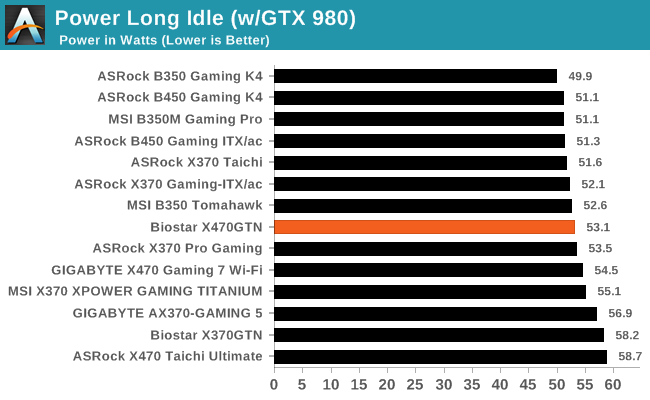
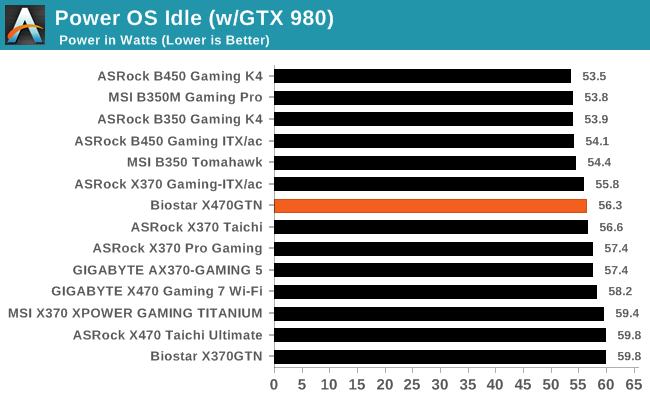

The power consumption on the X470GTN was middle of the road, despite being smaller than the majority of the boards on test. The result under load roughly matches that of the X370GTN and matches the result give by the same sized ASRock B450 Gaming ITX/ac motherboard.
Non-UEFI POST Time
Different motherboards have different POST sequences before an operating system is initialized. A lot of this is dependent on the board itself, and POST boot time is determined by the controllers on board (and the sequence of how those extras are organized). As part of our testing, we look at the POST Boot Time using a stopwatch. This is the time from pressing the ON button on the computer to when Windows starts loading. (We discount Windows loading as it is highly variable given Windows specific features.)
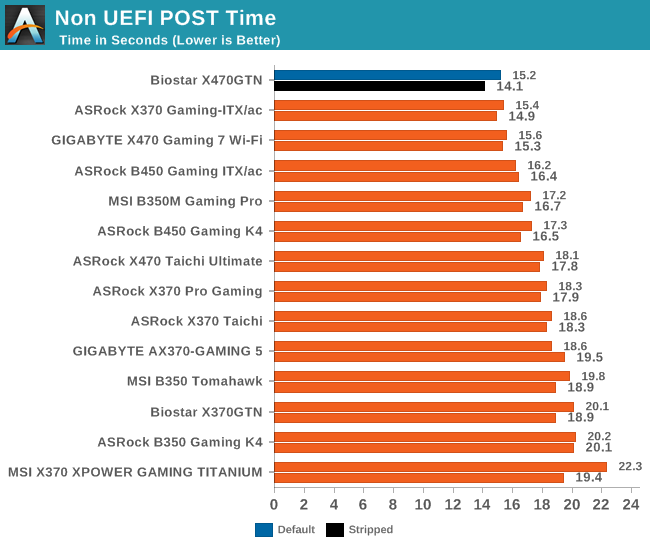
The Biostar X470GTN currently holds the fastest non UEFI POST time within our testing by the skin of its teeth and provides a good showing both at default, and with controllers turned off within the BIOS. This marks a notable improvement over the times procured from our testing of Biostars own X370GTN.
Rightmark Audio Analyzer 6.2.5
Rightmark:AA indicates how well the sound system is built and isolated from electrical interference (either internally or externally). For this test we connect the Line Out to the Line In using a short six inch 3.5mm to 3.5mm high-quality jack, turn the OS speaker volume to 100%, and run the Rightmark default test suite at 192 kHz, 24-bit. The OS is tuned to 192 kHz/24-bit input and output, and the Line-In volume is adjusted until we have the best RMAA value in the mini-pretest. We look specifically at the Dynamic Range of the audio codec used on the rear panel of the board.
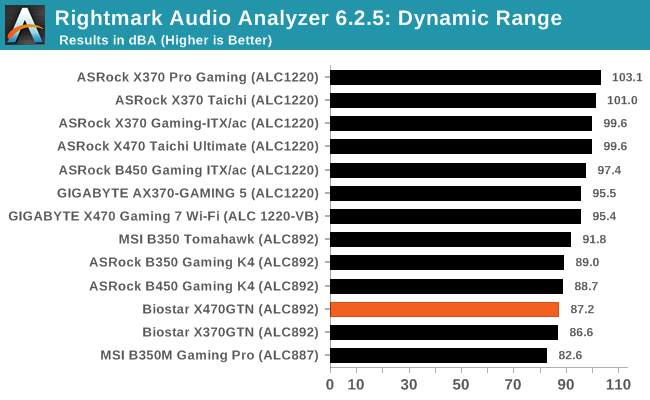
Our testing in RMAA fits with what we've experienced already with boards featuring a Realtek ALC892 HD audio codec. The testing indicates that it's notably better than the ALC887 in the dynamic range benchmark, but falls short of the performance outputted by the boards equipped with the more expensive and premium ALC1220 codec.
DPC Latency
Deferred Procedure Call latency is a way in which Windows handles interrupt servicing. In order to wait for a processor to acknowledge the request, the system will queue all interrupt requests by priority. Critical interrupts will be handled as soon as possible, whereas lesser priority requests such as audio will be further down the line. If the audio device requires data, it will have to wait until the request is processed before the buffer is filled.
If the device drivers of higher priority components in a system are poorly implemented, this can cause delays in request scheduling and process time. This can lead to an empty audio buffer and characteristic audible pauses, pops and clicks. The DPC latency checker measures how much time is taken processing DPCs from driver invocation. The lower the value will result in better audio transfer at smaller buffer sizes. Results are measured in microseconds.
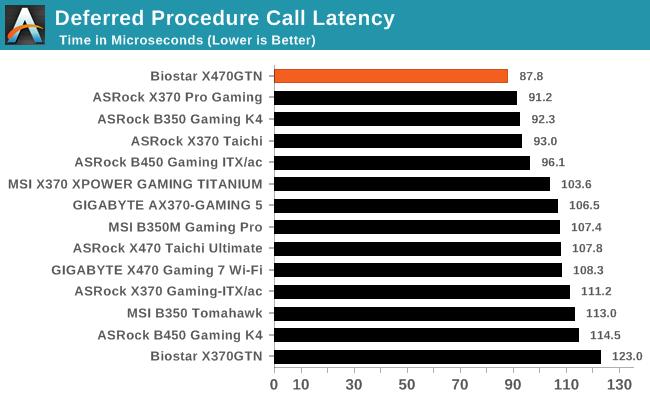
None of the boards on test have been optimized for DPC latency, but the Biostar X470GTN managed to again post the best result seen in some of our system benchmarking suites with a result that totally decimates the previous iteration of this same board, the X370GTN. To make sure there wasn't an anomaly, the test was run three times with two of three achieving a maximum latency of 87.8 microseconds.










18 Comments
View All Comments
Marlin1975 - Wednesday, October 24, 2018 - link
Thanks for the Power Delivery Comparison. That's something that is hard to check for if not in a good review. Keep up the good work.gavbon - Wednesday, October 24, 2018 - link
Thanks Marlin, appreciated! We're looking to further add to this going forwardMrCommunistGen - Wednesday, October 24, 2018 - link
I actually really appreciate this as well because this kind of information has been hard to come by in the past. I had some questions regarding the included table.The ASRock B450 Gaming ITX/ac is listed in the table as using the same controller (ISL95712) in "6+2" mode. The spec sheet for ISL95712 states that it is up to a 4+3 controller. The table also doesn't list any doublers. Doesn't this make the board a "big 3+2" rather than a 6+2?
I didn't look at any of the other boards in the table closely, but I was just doing a bunch of reading on the ASRock ITX boards recently and so I was looking very closely at that line in the table.
Thanks for the review!
TeutonJon78 - Monday, October 29, 2018 - link
It would help more if it was accurate.The ISL95712 maxes out at 4+3 phases, so it can't run in 6+2 as listed in the chart. On the ASRock boards, then run a 3+2 setup but with two sets of MOSFETs and chokes in parallel, but not doubled. There is only one capacitor per phase. It helps keep the temps down by splitting the current, but it's still only a 3 phase design.
Plus, it would be more meaningful if the chart was for similar style boards rather than a smattering of different form factors.In this case, the other m-ITX boards.
DanNeely - Wednesday, October 24, 2018 - link
Just thinking about POST times, when UEFI was the next big thing we'd been repeatedly promised that it'd allow 1-2s POST times because unlike BIOS it could start components up in parallel instead of 1 at a time.While current boards do post faster than their predecessors the speedup never came close to meeting the hype. Does anyone know why reality fell so short of the promise?
Dragonstongue - Wednesday, October 24, 2018 - link
likely because there is so much crud to siphon through before it completes the processthe same from going to post to OS log screen to fully booted OS
am sure there are ways to "speed it up" but often those methods come with chance of something terrible happening and not knowing what took place.
be happy the new stuff is WAY quicker and more energy efficient then the old 9/10 so even if it takes a wee bit longer to boot up, patience come to those whom wait.
SSD helps that much I know, but as far as only 1 to 2s to finish post..umm I personally never heard of such promises, the board I am using is AM3/3+ M5A99X EVO (v1) which uses a UEFI based bios design and just going from HDD to SSD made post much quicker and a few changes I made as well to speed it up also helped.
I personally have more issue with how long it takes to shut down then be fully booted up ^.^
Vatharian - Wednesday, October 24, 2018 - link
As fun as it sounds there are 10 year old systems that run on UEFI. I must say, that boot times are much quicker on them, while supporting much wider range of hardware. Feature-wise it's hit or miss, I have 9 year old board that's capable of booting from NVMe, thanks to drivers being easy to punch in, but it won't allow user mode to write to boot manager area, thus linux bootloader installation will fail (I just have to point the path manually from the UEFI setup).JoeyJoJo123 - Wednesday, October 24, 2018 - link
Ahmdal's Law, in a way. There is a relative speedup to be had, but desktops don't need to be shutdown/restarted extremely often. Often just letting it go into sleep mode is adequate for me, and leaves my workspace in exactly the same place it was before.For laptops or other mobile devices, shutting down is more necessary when moving between work environments, (given that sleep mode will drain battery life over time anyways, hibernate isn't ideal and can clog the main storage disk with a file equal in size to your capacity in memory, etc.). For mobile PC devices, I have personally noted that boot times are appreciably fast.
Also, personal anecdote, but I've had boards that when set to options for "fast booting", not only would it refuse to take in DEL or F11 prompts to get into BIOS screen when booting up, but it would go from a stable (normal) bootup, to a blazingly fast crash/reboot cycle for 5 loops before landing me back on the BIOS page with stock settings. This is before and after BIOS updates.
Personal opinion, but I just think it's intentional that for the enthusiast PC market that vendors don't _want_ to speed up boot times because the same users buying these motherboards are enthusiasts likely willing or needing to occasionally go into BIOS and change boot order of disks, or do overclocking features, etc. and making sure users can actually get into BIOS easily and reliably (hence a slow boot with ample time to opt-in to boot to BIOS) may have been one of their intended design goals.
Vatharian - Wednesday, October 24, 2018 - link
There is reverse effect in action: amount of stuff that is set to initialize during boot is staggering. I'd asku you to find 1MB legacy BIOS, while 16MB UEFI is not uncommon, and I am in a possession of motherboard that has 512 MB SPI flash for it (not 512 megabits - half a gigabyte). Then, amount of stuff you can boot from went trough the roof. On top of drivers for everything that need to start up and register, there are at least three different frameworks that monitor hardware and need to set up.Then, every damn power controller, voltage regulator, thermal zones, OC chips are smart need to boot up too.
Then, amount of memory skyrocketed - if you remember old BIOS happily running memcheck kilobyte after kilobyte, until it reaches that 64MB, and compare to you 64GB system, that still gets a cursory check, despite memory NOT being 1024x faster.
You can cut your boot time down, if you properly disable CSM, disable external controllers (or at least disable their boot rom), properly set up boot sequence to UEFI bootloader, and use GPU with a BIOS that supports GOP, and finally enable fast boot, your PC WILL boot in ~2-3 seconds plus OS.
On the other hand, while handling servers I am accustomed to boot times on the orders of 20 minutes at extreme case.
Death666Angel - Wednesday, October 24, 2018 - link
My system (H87 with NVME boot mod BIOS) gets to windows faster than my 4k DP monitor wakes up from standby. The DVI one is a bit faster. I guess around 3 seconds maybe?